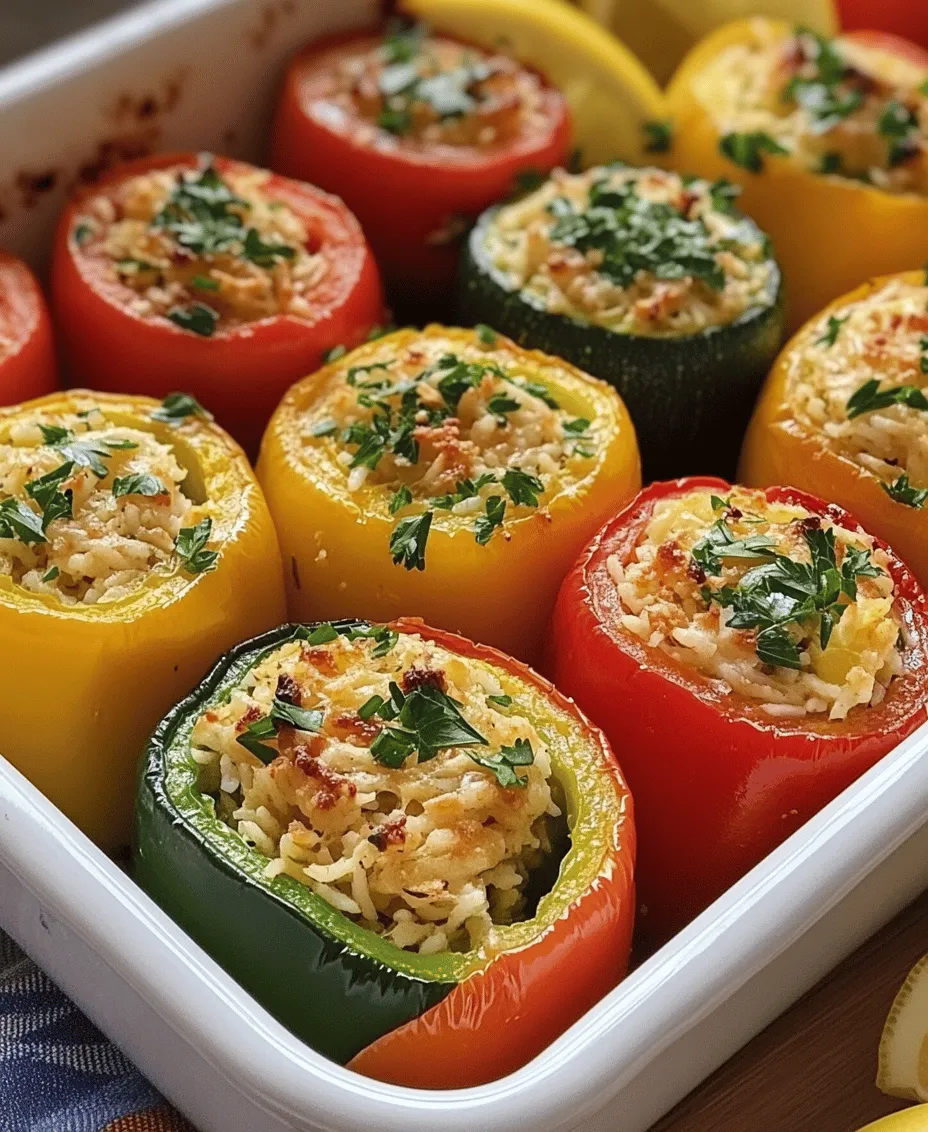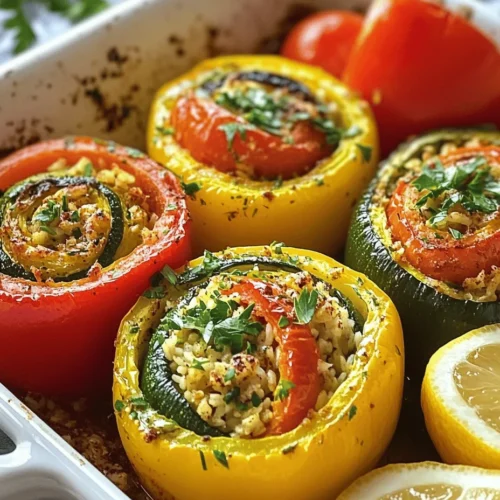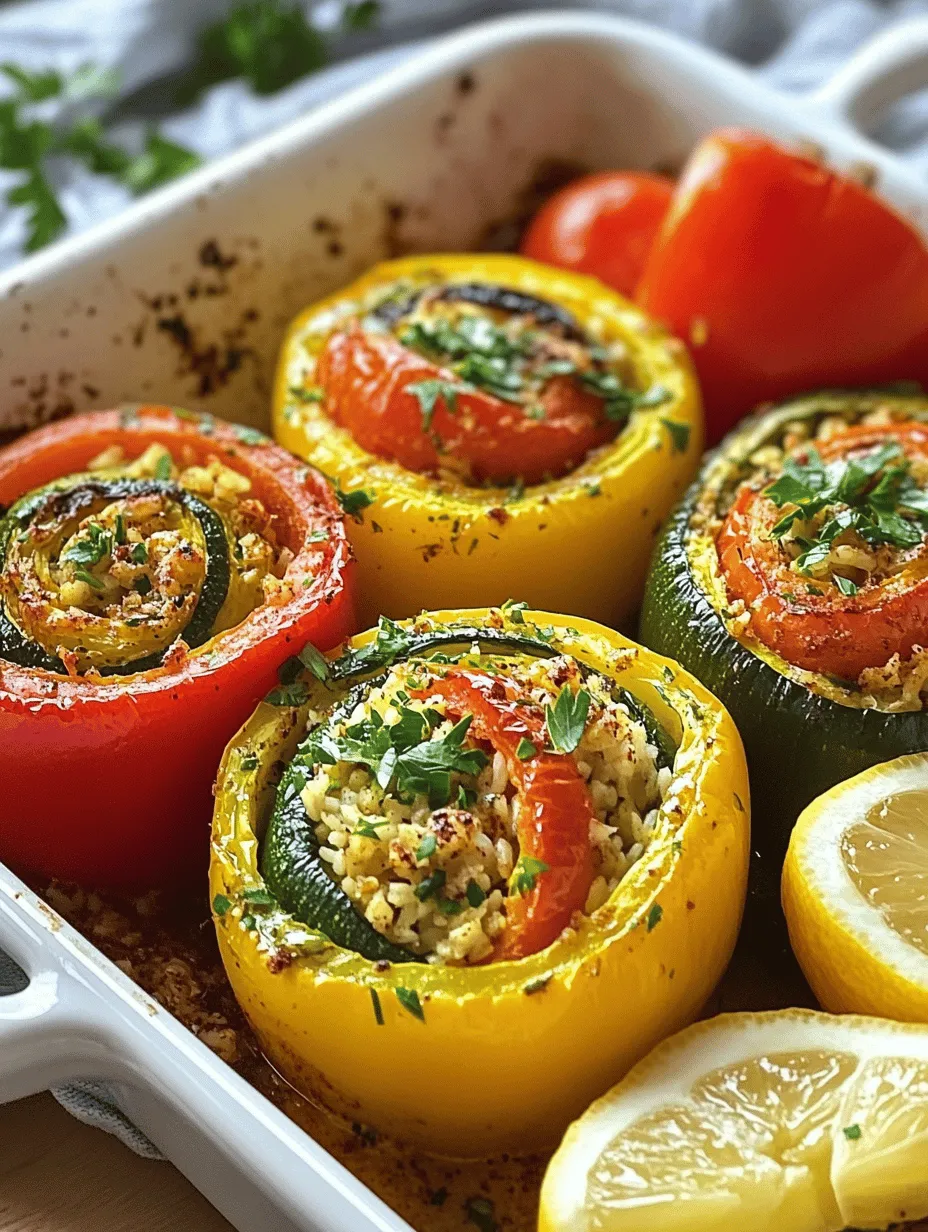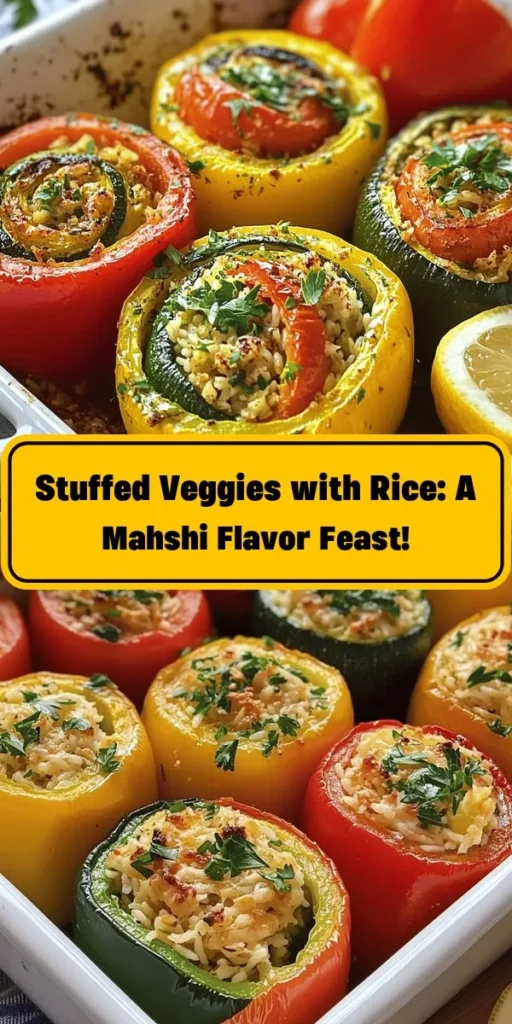Introduction
Mahshi, a beloved dish in Middle Eastern cuisine, captivates the taste buds with its delightful blend of flavors and textures. This traditional recipe features an array of fresh vegetables stuffed with a savory mixture of rice, herbs, and spices, creating a culinary masterpiece that resonates with both heritage and innovation. As Mahshi transcends cultural boundaries, it showcases unique variations, allowing each family to put their own spin on this cherished favorite. The dish is not only a comforting meal but also an excellent way to incorporate healthy ingredients into your diet.
Stuffed vegetables offer a multitude of health benefits. Rich in vitamins, minerals, and fiber, they are a great way to consume a variety of nutrients in a single dish. The combination of fresh produce with aromatic spices ensures that each bite is not only nutritious but also bursting with flavor. By prioritizing fresh, high-quality ingredients, you can enhance both the taste and nutritional value of your Mahshi Delight, turning an ordinary meal into an extraordinary experience.
Understanding Mahshi: A Cultural Perspective
Historical Background of Mahshi
The roots of Mahshi can be traced back centuries, with its origins deeply embedded in the culinary traditions of the Middle East. This dish has been cherished for generations, often served during festive occasions, family gatherings, and communal meals. Its rich history reflects the agricultural bounty of the region, where local vegetables are harvested and transformed into satisfying meals. In countries such as Egypt, Lebanon, and Turkey, Mahshi takes on unique characteristics, showcasing the diverse cultural interpretations that contribute to its widespread popularity.
Variations of Mahshi Across Regions
One of the fascinating aspects of Mahshi is its adaptability. Each region boasts its own version, influenced by local ingredients and culinary customs. In Egypt, for instance, stuffed zucchini and bell peppers are commonly filled with a mixture of rice, spiced ground meat, and aromatic herbs, while in Lebanon, Mahshi may feature grape leaves or eggplants, often accompanied by tangy tomato sauce. Turkish Mahshi, on the other hand, might include a variety of spices and even nuts, adding a distinct flair to the dish. This versatility not only highlights the creativity of home cooks but also emphasizes the importance of using seasonal ingredients that are readily available.
The Role of Stuffed Vegetables in Promoting Sustainability
In a world increasingly focused on sustainability, stuffed vegetables present an excellent way to minimize food waste. By using the entire vegetable, from the skin to the core, cooks can create meals that are both resourceful and delicious. The practice of stuffing vegetables allows for creativity in the kitchen, encouraging cooks to experiment with different fillings and flavors. As families gather around the table to enjoy Mahshi, they also engage in a cultural practice that honors the land and its produce, fostering a deeper appreciation for the food we consume.
Ingredients Breakdown
Creating the perfect Mahshi Delight begins with selecting the right ingredients. Each component plays a crucial role in the overall flavor and nutritional profile of the dish.
Long-Grain Rice
Rice is the cornerstone of Mahshi, and the type you choose can significantly impact the texture and taste of the dish. Long-grain rice, such as Basmati or Jasmine, is often preferred for its fluffy texture and ability to absorb flavors. Basmati rice, with its nutty aroma and delicate grains, pairs beautifully with the spices used in Mahshi, while Jasmine rice provides a slightly sweet flavor that complements the vegetables. Regardless of the choice, ensure the rice is thoroughly rinsed to remove excess starch, resulting in a light and fluffy stuffing.
Fresh Vegetables
The selection of fresh vegetables is pivotal in achieving a flavorful Mahshi Delight. Zucchinis and bell peppers are popular choices that not only lend themselves to stuffing but also provide a wealth of nutrients. Zucchinis are low in calories and high in vitamin C, potassium, and antioxidants, making them an excellent addition to any meal. Bell peppers, available in various colors, are packed with vitamins A and C, as well as fiber, adding both sweetness and crunch to the dish. When selecting vegetables, opt for firm, vibrant produce to ensure the best flavor and texture.
Aromatics
Aromatics, such as onions and garlic, form the backbone of many Middle Eastern dishes, and Mahshi is no exception. Onions add a sweet, savory depth to the stuffing, while garlic contributes a pungent, aromatic quality that elevates the overall flavor profile. Sautéing these ingredients before mixing them into the rice mixture enhances their flavors, creating a tantalizing base for the dish. Always choose fresh onions and garlic for the best results, as pre-packaged versions often lack the vibrancy and aroma that fresh produce offers.
Spices
The use of spices is what truly defines Mahshi, infusing the dish with warmth and complexity. Cumin, cinnamon, and allspice are traditional spices that play a vital role in Middle Eastern cuisine. Cumin lends an earthy, nutty flavor that complements the rice and vegetables, while cinnamon adds a subtle sweetness that balances the savory elements. Allspice contributes a unique warmth, reminiscent of cloves and nutmeg, creating a harmonious blend that enhances the stuffing. When preparing Mahshi, using whole spices that are freshly ground will provide the most potent and fragrant results.
Optional Ingredients
To further elevate your Mahshi Delight, consider incorporating optional ingredients such as pine nuts and raisins. Pine nuts add a delightful crunch and richness, while raisins contribute a touch of sweetness that contrasts beautifully with the savory stuffing. These ingredients not only enhance the flavor but also introduce additional textures, making each bite a delightful experience. Whether you choose to include them or not, these optional components allow for personalization, enabling you to craft a dish that aligns with your culinary preferences.
Preparation Steps for Mahshi Delight
The preparation of Mahshi Delight involves a few essential steps, primarily focusing on hollowing out the vegetables to create the perfect vessel for the stuffing.
Preparing the Veggies
Begin by selecting firm zucchinis and bell peppers that are ideal for stuffing. To hollow them out, carefully slice the tops off the vegetables and use a small spoon or melon baller to scoop out the insides, leaving enough flesh around the edges to maintain their structural integrity. For zucchinis, be sure to extract enough of the center to create ample space for the rice mixture while keeping the outer layer intact. In the case of bell peppers, remove the seeds and membranes without puncturing the sides, as this will help to hold the stuffing securely.
Once the vegetables are prepped, it’s essential to prepare the stuffing, ensuring that the rice, spices, and aromatics are well-combined. This step is crucial for achieving a balanced flavor throughout the dish. As you mix the ingredients, take a moment to taste and adjust the seasoning, allowing the spices to shine and the aromatics to permeate the mixture.
By following these initial steps, you are well on your way to creating a Mahshi Delight that is not only visually appealing but also packed with flavor and nutrition. As you continue to assemble and cook the stuffed vegetables, the enticing aroma will fill your kitchen, inviting everyone to gather around the table and enjoy this flavorful journey into rice-stuffed veggies.

Preparing the Rice Filling
To achieve the perfect filling for your Mahshi Delight, the first step is to prepare the rice correctly. Rinsing the rice is crucial as it removes excess starch, which can cause the cooked rice to become gummy rather than fluffy. Place your rice in a fine-mesh sieve and rinse it under cold tap water until the water runs clear. This process not only helps with texture but also enhances the overall taste of the dish.
Once the rice is rinsed, it’s time to sauté the onions and garlic. Heat a tablespoon of oil in a pan over medium heat. Add finely chopped onions, allowing them to become translucent before adding minced garlic. The aromatic combination of onions and garlic forms the backbone of flavor in your stuffing. Sauté for about 3-4 minutes, stirring occasionally, until they are golden and fragrant. This step adds a depth of flavor that will permeate the rice and vegetables.
Toasting Spices
Spices are the heart of Mahshi, and toasting them beforehand elevates their flavors significantly. Use a dry skillet over medium heat and add your selected spices—commonly cumin, coriander, and allspice. Toast them for 2-3 minutes, stirring constantly, until they become fragrant. Be cautious not to burn them, as that can impart a bitter taste. Toasting releases the essential oils in the spices, enhancing their flavors and allowing them to infuse the rice filling beautifully.
Combining Ingredients
After toasting the spices, it’s time to combine them with the other ingredients. Add the rinsed rice to the sautéed onions and garlic mixture, followed by your toasted spices. It’s essential to cook the rice partially before stuffing it into the vegetables; this means cooking it for about 5-7 minutes until the grains are slightly opaque but still firm. This ensures that the rice will finish cooking inside the vegetables without becoming mushy.
Next, fold in a generous amount of fresh herbs, such as parsley and dill, which add brightness and freshness to the filling. You can also include pine nuts or currants for added texture and sweetness. Season the mixture with salt and pepper to taste, ensuring that the flavors are well balanced. Set the filling aside to cool slightly before moving on to the stuffing process.
Stuffing and Baking: The Art of Mahshi
Stuffing the vegetables is where the magic of Mahshi truly comes to life. Take your prepared vegetables—zucchini, bell peppers, or grape leaves—and start with a small amount of the rice filling. Use a teaspoon or your fingers to gently pack the filling into each vegetable, being careful not to overstuff. Leave some space at the top to allow the rice to expand during cooking. This technique prevents spillage and ensures even cooking throughout.
Once all the vegetables are stuffed, arrange them in a baking dish. Next, add a layer of water or vegetable broth to the bottom of the dish. This liquid is critical for the steaming process, which helps keep the vegetables tender while allowing the rice to cook thoroughly. Cover the dish tightly with aluminum foil to trap steam, ensuring moist cooking conditions.
Bake your Mahshi in a preheated oven at 375°F (190°C) for about 45 minutes to 1 hour. The vegetables should be tender and the rice fully cooked. You can check for doneness by inserting a fork or knife into the vegetables; they should be soft yet still hold their shape.
Serving Suggestions for Mahshi Delight
When it comes to serving Mahshi, presentation is key. Arrange the stuffed vegetables on a large platter, drizzling any remaining cooking liquid over them for added flavor. You can create a colorful display by mixing and matching different types of stuffed vegetables, showcasing the vibrant colors of the dish.
Pair Mahshi with a refreshing side salad, such as tabbouleh or a simple cucumber-tomato salad dressed with lemon and olive oil. These sides complement the richness of the stuffed vegetables and add a bright contrast to the meal. For beverages, consider serving a chilled mint tea or a light, crisp white wine that can enhance the flavors of the dish.
Garnishing is an essential step in elevating the presentation of Mahshi. A sprinkle of freshly chopped parsley or mint can add a touch of color, while wedges of lemon served on the side allow guests to brighten their servings with a squeeze of citrus. This simple addition not only enhances the dish visually but also adds a refreshing zest that balances the rich flavors.
Health Benefits of Mahshi Delight
Mahshi Delight is not only a feast for the senses but also a nutritious addition to your diet. The primary ingredients—rice and a variety of vegetables—offer a wealth of health benefits. The vegetables used in Mahshi are packed with essential vitamins and minerals. Zucchini, bell peppers, and tomatoes, for instance, are rich in vitamin C, antioxidants, and dietary fiber.
The fiber content from both the vegetables and the rice supports digestive health, making Mahshi a filling yet healthy option for any meal. The inclusion of fresh herbs not only boosts flavor but also adds additional vitamins and phytonutrients that benefit overall health.
Moreover, Mahshi is a fantastic plant-based meal, suitable for those looking to reduce meat consumption in favor of more plant-based foods. Incorporating dishes like Mahshi into your regular meal rotation can help balance your diet while offering a satisfying and delicious eating experience.
Conclusion
Mahshi Delight is a delicious and nutritious dish that brings together the warmth of home-cooked meals and the joy of sharing food with loved ones. The combination of fluffy rice, fresh vegetables, and aromatic spices creates a tapestry of flavors that is both comforting and satisfying.
By exploring this recipe, you’re not just preparing a meal; you’re embracing a culinary tradition that celebrates the beauty of cooking at home. So gather your ingredients, invite your friends or family, and make Mahshi a part of your regular meal repertoire. As you savor each bite, remember the importance of sharing meals and the rich cultural significance of food prepared with love. Enjoy the delightful experience of cooking and sharing Mahshi Delight with those who matter most.



